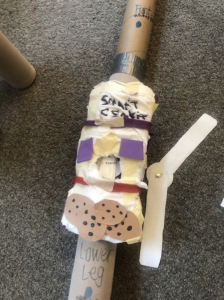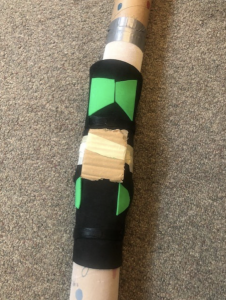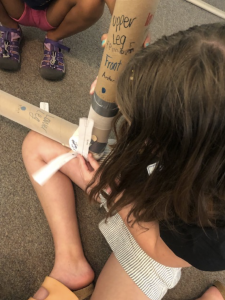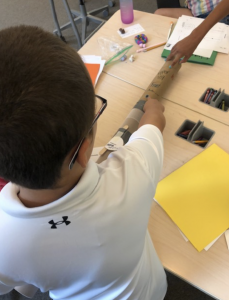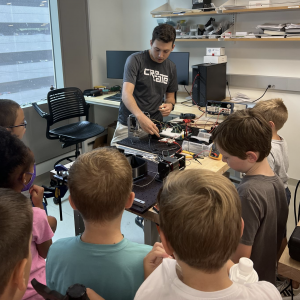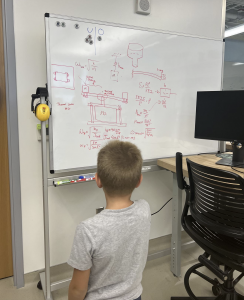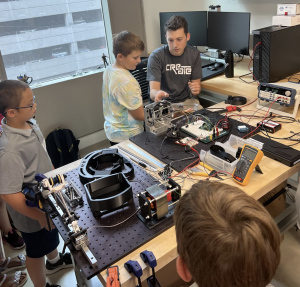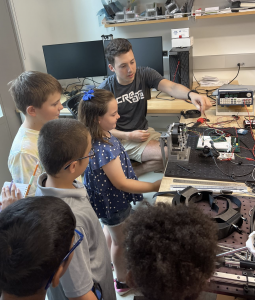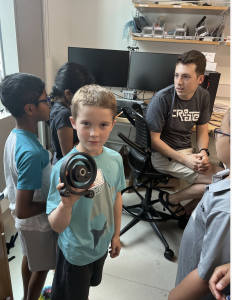Summer SAVY 2022/Session 5 – Biomedical Engineering for Rising 3rd/4th Grade
Friday: Happy Friday!
Biomedical Engineers were hard at work today! From a plan to a prototype- we created our knee braces that would help Mattias’ injured knee function like a healthy knee. I am SO proud of how well each Engineering Design Team worked as a TEAM! Ideas were shared, engineers collaborated, and problems were solved. We moved through the entire design process to ultimately create a successful prototype. Ask your student about what problems they encountered during the “Create” process. How did they solve that problem? How did working as a team or collaborating with other engineers impact your design? Were there problems that you couldn’t solve? If you had to create a new design for a knee brace, what features would it have? What materials would you use and why? Your student might have come home with their final project. If not, it’s possible that they let their teammate take it home. Again, I cannot express how well everyone worked together!
Some final takeaways from today were: the properties of a material determine its usefulness for different parts of a design; the Engineering Process can be used to solve problems; models can be especially useful during the “Create” step of the Engineering Design process; apply knowledge of range of motion of a healthy human knee to inform designs; use knowledge of properties of materials when selecting materials for their designs.
Thank you so much for a wonderful and inquisitive week of creating and designing! We hope to see you at another SAVY session soon!
Check out the pictures of some prototypes! What features do you see?
Warmly,
Ms. Courtney and Ms. Emma
Thursday: Happy Thursday!
We are working our way through the Engineering Design Process and applying our learning to our knee brace designs. Today we explored the range of motion for the unhealthy knee model and compared and contrasted the data from our goniometers to the data from our healthy knees. We determined reasons for variance in healthy knees and in comparison to injured knee models.
We applied learning to create an improved design sketch. Some ideas were adding a hot/cold therapy pack for swelling/pain, including support for knee to prevent bending in incorrect ways, and including material that will limit range of motion. We even considered personalization such as Pikachu designs and stickers, holes and material choices for comfort and air flow.
Some key takeaways from today include: models can be used to test design ideas; based on their properties, different materials can be used in different parts of a knee brace design; the properties of a material determine its usefulness for different parts of a design; the Engineering Process can be used to solve problems; models can be especially useful during the “Create” step of the Engineering Design process; apply knowledge of range of motion of a healthy human knee to inform designs; use knowledge of properties of materials when selecting materials for their designs
Some dinner table questions:
- What materials did you choose for your knee brace and why?
- What improvements have you made to your knee brace design through the Engineering Design Process?
- What are some problems you’ve run into? How do you think you can solve them?
Check out some photos from today’s learning!
Have a wonderful evening!Warmly,
Ms. Courtney and Ms. Emma
Wednesday: Happy Wednesday!
Our day started off with a presentation from our guest speaker, Dr. Norwood, PT, DPT. She explained the parts of the knee including its main bones and ligaments. She explained five main types of knee braces, their function and design, and their pros and cons. We learned about what physical therapy is and how the goal is to help the body regain typical function with as limited outside supports as possible, as well as what it takes to become a physical therapist. Ask your learner what they learned from Dr. Norwood.
Next, we used the information we’ve learned from Dr. Song, Dr. Norwood, and in class to sketch our initial design ideas. Be sure to check out the photos! We began the first step in the engineering design process and worked as a class to create these questions – Ask: How do we build and create a functional knee brace that can help Mattias’ injured knee work like a healthy knee with the materials and tools available? What shape, size, and features would create the type of brace to help his knee get better?
To apply our knowledge, we labeled our injured knee models and explored range of motion using a goniometer of our healthy knees. We wrapped up our day with a virtual visit with a biomedical engineering student from University of Mississippi and “toured” Engineered Medical Systems’ factory floor where they machine biomedical technologies such as medical implant screws used in various surgeries.
Some key understandings from today were: the human knee does not move freely- its motion is restricted to certain directions, models can be used to test design ideas, and based on their properties, different materials can be used in different parts of a knee brace design.
Some dinner table questions:
What is a joint?
How do our healthy knees move?
What are some common injuries of the knee and what technologies have been engineered, or could be engineered, to fix them?
See you tomorrow!
Warmly,
Ms. Courtney and Ms. Emma
Tuesday: Happy Tuesday! What a busy day we had! First we got a chance to explore the engineering side of biomedical engineering and toured Dr. David Braun’s Advanced Robotics lab over on the main campus. We learned from PhD students as they explained their research and prototypes. Each of these students study mechanical engineering and work through the engineering design process to build robots that will help aid various features of the human body. Ask your learner about what they learned and enjoyed most! Then, Dr. Song, a physical sports medicine doctor, spoke with us about the anatomy of the knee, common injuries and his pathway to becoming a doctor. We learned about torn ligaments and tendinosis. Finally, we asked, How Do Biomedical Engineers Collect and Analyze Data about the Human Body to Help Design Technologies? We took on the role of biomedical engineers hired by “Fast Feet Shoe Company” to collect and analyze data about foot shapes, sizes, and arch heights and used this data to recommend how many different types of shoes the company should design.
Big takeaways from today are that engineers collect and use data about the human body and how it works to inform the design of various technologies, there is natural variation in the shape and size of human feet, and athletic shoes are an example of technology.
Check out the photos from our day!Some dinner table questions:
-Why is it important as a biomedical engineer to use data to inform designs?
– Why do you think _____ is designed that way?
– Look at the soles of your shoes. Where are they most worn? What does that tell you about the way that you walk? What could the shoe designer could have done differently in the design to prevent your shoe from wearing down where it did?
See you tomorrow!
Warmly,
Ms. Courtney and Ms. Emma
Graduate Students Students: first row, first picture Kim Sung, last picture Tiange Zhang, rest of the pictures Chase Mathews
Monday: Happy Monday and welcome to Biomedical Engineering! Our class is off to a great start. We had a wonderful day getting to know each other and diving into the world of technology, engineering, and design. Today, we discovered our challenge for the week:
“Oh, no! Biomedical engineers need your help in designing and creating a functional knee brace to help Matthias’ hurt knee. The biomedical engineers have had several meetings to decide how to design the brace, but everyone seems to have different ideas about the material it should be made from, what shape it should have, and what special features would be important. The adults cannot seem to agree on a design, so now the engineers have decided to ask you for your ideas!”
We learned that biomedical engineers design technologies that solve problems related to the human body and medicine and that the parts of the knee serve specific functions that allow the knee joint to move. We explored examples of technology and decided that knee braces are an example of technology. Finally, we discussed that the Engineering Design Process is a series of steps that can be used to solve problems. Ask your child about the story called Erik’s Unexpected Twist and how he and his fellow campers worked through the steps of the engineering design process to help out a friend!
Dinner Table Questions:
-
Explore the technology around your house: How do you know that it’s a piece of technology? Is the object naturally made? Man-made? What material is it made of? What problem does it solve? How else could you use it? What other materials could it be made of? Who creates these technologies? Why was this technology created? What problems need solutions around your house and what can you design to solve that problem or help make life easier?


